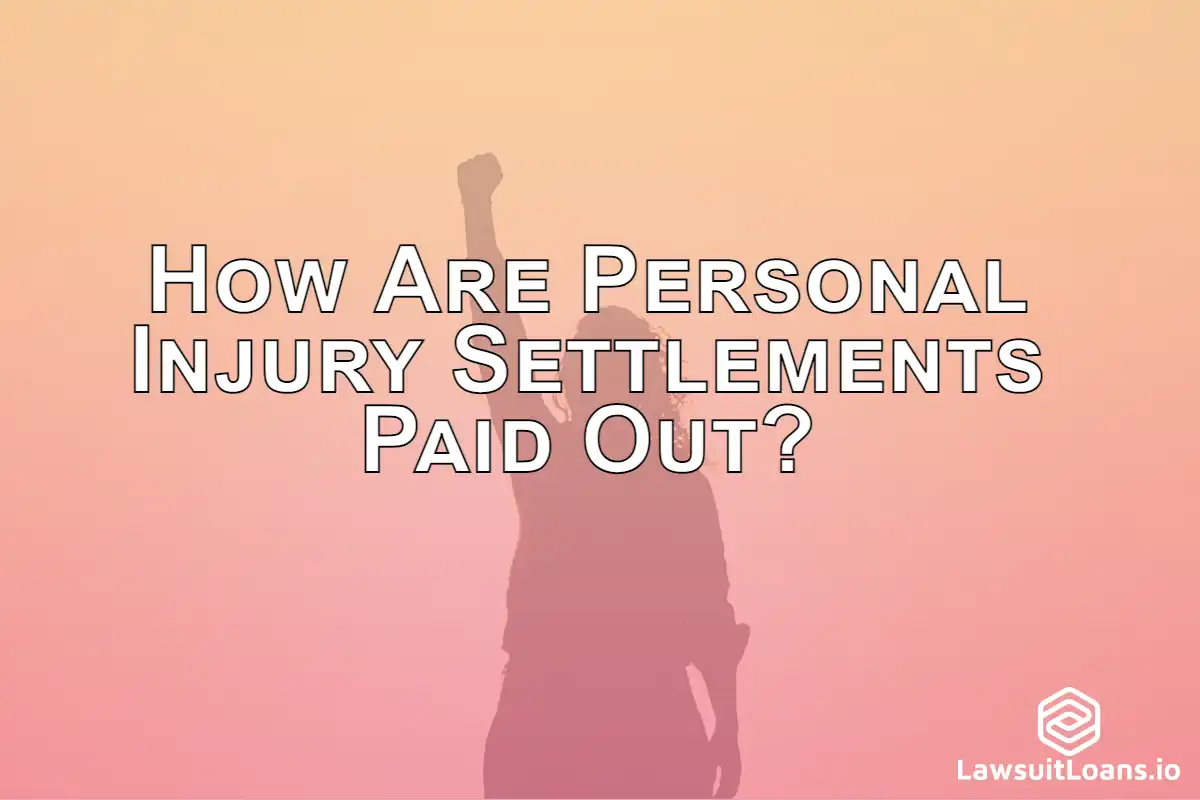How Are Personal Injury Settlements Paid Out?
Learn about how personal injury settlements are paid out, including key takeaways, common payment options, and if settlements are taxable.




How Are Personal Injury Settlements Paid Out?
When an accident caused by the negligent, reckless, or careless behavior of someone else leaves you injured and unable to work, financial pressures mount as you struggle to pay medical bills and household expenses. If you find yourself in this situation, you probably want to know how your personal injury settlement will be paid.
Typically, once your personal injury lawyer and the insurance company for the party responsible for causing the accident negotiate a settlement agreement, payment of the claim can be in the form of a one-time, lump-sum payment or something that attorneys refer to as a “structured settlement, which entails a series of payments spanning an agreed-upon time period.
The following information is offered in order to give you a better idea of how the settlement process and payment of your personal injury claim works. It should help you to make decisions in consultation with your personal injury attorney about the payment option that works best for you and your financial needs.
Apply NowKey Takeaways
A few of the key things to remember when it comes to personal injury settlements and how they are paid out include:
- The severity of the injury, medical costs to date and those anticipated in the future, present and future lost or diminished earning capacity, and pain and suffering generally determine the amount of a personal injury settlement.
- Most settlements in personal injury cases are paid in a lump sum, but structured payouts may be a better option in some circumstances.
- Medical liens, legal fees, and lawsuit costs usually must be paid before the plaintiffs receive their portion of the settlement.
- It takes time for insurance companies to process and send a settlement check to the personal injury attorney and for the check to clear before the plaintiff receives the net settlement.
- Personal injury settlement payments are not taxable as income to the plaintiff.
Get up to $500,000 With Rates as Low as 2.5% Simple, Monthly
A Step-By-Step Guide to How The Settlement Process Works
Negotiations to achieve a settlement of your personal injury claim may be initiated at any time by your attorney or by the adjuster or lawyer working on behalf of the insurance companies for the person at fault in causing the accident. The settlement negotiations sometimes begin before a personal injury lawsuit is filed, or there may be no discussions about settlement until the case reaches court and the trial begins. It really depends on when both sides in the case believe the time is right to discuss a settlement.
It is not at all unusual for a settlement to be negotiated while jurors are attempting to reach a verdict after both sides have produced their witnesses and other evidence. The main thing to keep in mind about the process is that your lawyer will attempt to reach a settlement agreement whenever possible as long as the offer provides sufficient compensation for the damages, including pain and suffering, caused by the negligence of the party who was at fault.
If both sides agree to settle the claim, a written settlement agreement will be prepared and presented for approval to the judge presiding over the case. Wrongful death cases and lawsuits filed on behalf of children may require a brief hearing to obtain a court order approving the settlement.
When a settlement is reached in a personal injury case, the insurance company paying the claim askes your lawyer for a signed release of liability form from you acknowledging settlement of all claims against the insured and the insurance company before it sends a check for the settlement amount to your attorney. The check is payable to both you and your lawyer and must be deposited into the lawyer’s escrow or attorney trust account.
Each state has its own rules governing lawyer trust accounts, but the general principle behind them is for money received by attorneys on behalf of their clients be held in a bank account separate and apart from funds belonging to the lawyer or law firm. When the insurance company makes the check payable to you and your lawyer, it requires two signatures showing the funds must be deposited into a trust account.
After the insurance check clears, the lawyer will write a check to pay legal fees and court costs related to the case, pay medical liens by writing checks to the doctors or hospitals holding a lien against the settlement, and write a check to you for the remainder of the settlement funds.
If some of your medical bills were paid through a health insurance policy, the insurance company may have a lien that your lawyer will pay from the settlement. The same is true when you are injured in a work-related accident and file a claim for workers’ compensation benefits. The workers’ compensation insurance company may have a lien that must be paid from the personal injury settlement for the money it paid to you. Your lawyer will explain all documents and steps in the payment process before you sign anything and prior to disbursement of settlement funds.
How Long Does It Take For The Settlement Check To Clear?
It can take about two weeks for the settlement check to reach your attorney, be deposited into the escrow account, and for the funds to clear before checks may be written against the settlement funds. There is a different payment process when a structured settlement is chosen over a lump-sum payment.
Get Started
Apply today and get funds in as little as 24 hours!
Settlement Payment Options
A settlement may be paid as a one-time, lump-sum payment or the payments may be spread out over time through a structured settlement. There are advantages and disadvantages to each method of payment, so it is important to understand them in order to choose the best payment method for your particular situation.
Lump-Sum Payment
If you wish to have all of the net settlement proceeds available to you, then a lump-sum payment may be the best option for you. That way, you have all of the money to invest, purchase a home or do anything else you want with it.
The advantage of having the settlement funds under the control of the plaintiff also can be a disadvantage to lump-sum payments. For example, a plaintiff who is a spendthrift or has a gambling or addiction problem may end up squandering their settlement money. A structured settlement could be a better option for such a person.
Structured Settlement
A structured settlement is when a plaintiff receives a settlement in periodic payments instead of a single, lump sum. The payments can be structured to receive them monthly, quarterly or at any interval you choose and extend them for years into the future. This flexibility and ability to avoid getting all of the money at once is one of the advantages of a structured settlement.
The liability insurance company and your lawyer reach a settlement and agree upon the amount and frequency of the periodic payments. The insurance company issues a check in payment of legal fees and court costs incurred by your personal injury lawyer and to pay liens for medical expenses. The liability insurance company then pays the cost of an annuity from a third-party insurance company that will cover the periodic payments that you receive under the structured settlement.
A key advantage of a structured settlement is that it avoids the risk of a plaintiff spending the settlement too quickly and having nothing available for the future. A disadvantage is that your money is controlled by an annuity company that only pays according to the schedule that you set up with help from your lawyer when the settlement was agreed upon, so money may not be available for an unanticipated expense or investment opportunity that comes your way between scheduled payments from the settlement.
Are Personal Injury Settlements Taxable?
As a general rule, the money that you receive in settlement of a personal injury claim is not taxable. They are not subject to state or local income taxes. However, if a portion of the settlement payment is designated as punitive damages, they are subject to federal taxation and may be subject to state taxes depending on the laws where you reside at the time of the settlement.
Get $500 – $500,000 in as Little as a Single Business Day!
We understand that if you’re applying for funding with us, you needed the funding yesterday. With your attorney’s cooperation, we can provide funding as soon as the same business day.
Basic Personal Injury Lawsuit Settlement Breakdown
Most people don’t realize how much actually goes into a personal injury lawsuit settlement. Yes, the victim usually receives the majority of the funds, but there are several key players that get a portion of the settlement as well.
Attorneys Fees and Case Costs
The first group of funds that gets taken out of a settlement are the attorneys fees and case costs. Your attorney will almost always take a contingency fee, which is a percentage of the final settlement award. Most contingency fees are between 33-40%. This means that if you receive a $100,000 settlement, your attorney will take home approximately $33,000-$40,000. This number can be negotiated however, so if your attorney is asking for a higher contingency fee, it’s important to ask why. In addition to attorney’s fees, there may be other costs associated with your case that your attorney charges you for. These costs can include things like filing fees, court reporter fees, expert witness fees, etc. Case and litigation costs can range anywhere from a few hundred dollars to tens of thousands of dollars.
Medical Liens
Next, any outstanding medical liens will need to be paid. A lien is simply a claim that an institution has on a settlement. So, if you have outstanding medical bills from your accident, those bills will need to be paid out of your settlement. Your attorney will work with you to determine what portion of the settlement will go towards medical liens. Generally, medical liens take precedence over most other liens, with the exception of child support liens and federal tax liens.
Plaintiffs Share
After attorneys fees, case costs, and medical liens have been paid, the rest of the settlement funds will be distributed to the plaintiff. In most cases, the entire settlement will be sent to the plaintiff in one lump sum. However, in some cases, the settlement may be paid out in installments. This is generally done when the plaintiff has significant future medical expenses that need to be taken care of.
Conclusion
A lump-sum settlement may be the most commonly used method to settle a personal injury claim, but it may not be the right option for you. Discuss it and the terms of a structured settlement with your lawyer to choose the one that best suits your current and future financial needs.
If you choose the lump-sum settlement option, the fault driver’s insurance company in a motor vehicle accident legal action will process the payment and send a settlement draft to your attorney who will deposit it in a trust account. Legal fees and legal claims made for payment of medical expenses will be paid from the money in the trust account with the remaining settlement funds disbursed to you.
If you are awaiting payment from a settlement or verdict and need money right away, LawsuitLoans.io is a lawsuit loan company offering personal injury loans for your personal injury court case at rates as low as 2.5% simple interest per month. The money advanced is repaid from the settlement or verdict. Learn more by contacting LawsuitLoans.io for more information at (800) 340-4973 or apply online.
Related Articles: